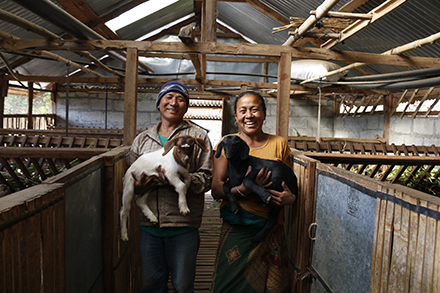
Narmaya and her husband Khem Bhadur Thapa, both in their 50s, were ready to move away from their rural home in Pathadi village to begin a new life in the city.
“My son has been working in Qatar for two years now,” Narmaya said. “His wife and two sons are living in the city now. It is just us two here [at home].”
She and her husband had sold their ancestral land in the village, but—at the last minute—they had a change of heart.
When women from the village formed started forming community groups through Heifer, Narmaya decided to join, too. Her group comprises of 32 members, all women. Members take turns helping one another with their farms, organizing village cleaning campaigns, assisting one another when there is a marriage or a death in a family, and so on. They also started a group fund to collect monthly individual savings. The reserve is used as a source for accessing credit at affordable rates. The group invested 60,000 rupees, or about $600, in tomato tunnel farming and anticipate selling the tomatoes and add to their incomes soon.
This new way of life for the families in Pathadi village helped Narmaya and Khem Bhadur stay in their home village after all. They also plan to buy back their ancestral land.
“This is home; I have a life here,” Narmaya said. “I know everyone and they know me, too. I know they will support me when I need, and I will do the same for them.”
This is home; I have a life here. I know everyone and they know me, too. I know they will support me when I need, and I will do the same for them. Narmaya, Heifer project participant
After receiving training on animal management, as well as business and financial management, the couple scaled up their goat farm. They invested 550,000 rupees, or about $5,500, to build an improved goat shed and plant fodder and forage in previously barren land. They learned how to keep records of their expenses and income from their farm.
“We didn’t understand profit or loss before,” Narmaya says. “I would sell a goat at 10,000 rupees, or $100, but now even a small goat goes for 12,000 rupees, or $120, easily.” They earned 257,430 rupees, or about $2,570, by selling 26 goats this year and still have 36 healthy goats on their farm.
Despite representing half the population, women are disproportionately affected by hunger and poverty and their underlying causes. Read more about our work to empower women.
In response to the increase in goat production, traders have started coming to village on trucks. Narmaya and her group members take their goats to be weighed and sold at a fixed price.
“A lot has changed since Heifer came to our village,” a fellow group member shares. “We have learned many things that are benefitting us. We have invested a lot of our time and resources to build sheds, plant fodder and take care of our goats. So, I think the project’s impact will continue for a long time.”
Read more stories of how Heifer empowers women around the world.
Narmaya and her group members are helping the village thrive. While many people sought foreign employment or moved to the city for menial jobs, she and her husband decided to stay and invest in their own village and work to strengthen the rural economy.